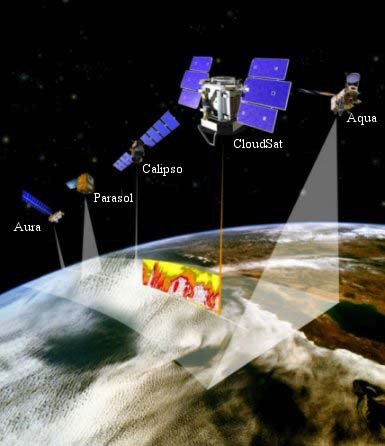| SPACE TODAY ONLINE COVERING SPACE FROM EARTH TO THE EDGE OF THE UNIVERSE | ||||||||||
| COVER | SOLAR SYSTEM | DEEP SPACE | SHUTTLES | STATIONS | ASTRONAUTS | SATELLITES | ROCKETS | HISTORY | GLOBAL LINKS | SEARCH |
Terra · Aqua · Aura
CALIPSO: Aerosols in the Atmosphere
TERRA »» AQUA »» AURA »» CLOUDSAT »» CALIPSO »» OCO »» PARASOL »» A-TRAIN »»
Flying in the A Train of satellites 438 miles above Earth, CALIPSO will search for airborne particles in the atmosphere so we can better understand how clouds affect our environment.
Click to enlarge NASA artisit's view of CALIPSO in orbit
CALIPSO's tool:
CALIPSO carries a LIDAR – a Light Detection and Ranging – for remote sensing of clouds and atmospheric aerosols that influence Earth's climate.
The LIDAR uses a laser beam to illuminate a target. Information about the target can be learned when the light bounces back from the target. That's called back-scattered reflectance or fluorescence.
For example, chlorophyll pigments in coral reef organisms such as algae, sea grasses and coral glow red (longer wavelength) when bathed in blue or green light (shorter wavelength).
Data from CALIPSO's LIDAR will help meteorologists deliver improved predictions of global climate change.
Prior to CALIPSO and its companion CloudSat, there were uncertainties about the role of clouds and aerosols in the climate system, because it had been difficult to measure those from space. CALIPSO is a new active way of looking at the atmosphere, which is an improvement over older passive instruments.
Prior satellite instruments have passive, observing scattered sunlight and radiated heat in an attempt to measure the altitude and properties of clouds and aerosols. A NASA scientist compared the new LIDAR with older passive instruments as the difference between an X-ray photograph and a CAT scan.
CALIPSO will use a laser to actively sense where they are located, similar to the way radar works.
CALIPSO's management:
CALIPSO is part of NASA's Earth System Science Pathfinder program. It is a collaboration between NASA, the French space agency Centre National d'Etudes Spatiales (CNES), Ball Aerospace, Hampton University, and France's Institut Pierre Simon Laplace.CALIPSO will be launched in 2005 from Vandenberg Air Force Base, Calfornia, sharing the ride with NASA's CloudSat on a Delta 2 rocket.
- Ball Aerospace built CALIPSO's science instrument and communications gear, including the lidar and wide field camera.
- CNES provided a three-channel imaging infrared radiometer, and will monitor and command CALIPSO on its 36-month mission.
CloudSat will use a millimeter wave radar to measure clouds.
CALIPSO and other Earth Observing System research is funded by NASA's Earth Science Enterprise, which is dedicated to understanding the Earth as an integrated system and applying Earth System Science to improve prediction of climate, weather and natural hazards using the unique vantage point of space.
In the A Train:
CALIPSO and CloudSat will fly in orbit around Earth in a tight formation, part of a constellation of Earth-observing satellites including Aqua, PARASOL, and Aura. As a group, the satellites have been referred to as the A Train.
The combination of data from the CloudSat radar with coincident measurements from CALIPSO and Aqua provides a rich source of information that can be used to assess the role of clouds in both weather and climate.
CALIPSO is likely to work three years in the same sun-synchronous, 438-mi.-high orbit of the Aqua satellite.
The environmental satellites Aura, Aqua, Terra, CloudSat, CALIPSO and PARASOL are referred to as the A Train in space because the caravan will resemble a train of satellites flying around Earth. The A-Train reference comes from a jazz tune, Take the 'A' Train, about riding a subway to New York City's Harlem, written in 1941 by Billy Strayhorn and made famous by jazz maestro Duke Ellington. [ lyrics »» ]
Click to enlarge NASA artist concept of the A Train satellites above Earth
In orbit, the sequence of six satellites in the convoy runs from Aqua to Aura. Each is part of NASA's fleet of Earth watching satellites that the space agency refers to as the Earth Observing System.
The ability to reduce risk is a benefit of flying satellites in formation. Sets of less costly, less expensive, less complex satellites means that failure of one does not kill an entire mission.
Formation flying:
Formation flying is a station keeping exercise that enables CloudSat to track the orbit of CALIPSO in a very precise way.
The CALIPSO orbit will be adjusted and monitored to keep it a fixed distance from CloudSat. The spacecraft will be controlled so both sets of sensors view the same ground track for the majority of the time. The average separation between the satellites will be about 286 miles which corresponds to approximately 60 seconds delay between lidar and radar measurements.
Formation flying with CloudSat provides direct overlap of the lidar footprint within the footprint of the radar most of the time.
| Learn more: | |
Aura:
|
CloudSat:
|
| Terra | Aqua | Aura | Earth | Satellites | Solar System |
| Search STO | STO Cover | Questions | Feedback | © 2004 Space Today Online |

